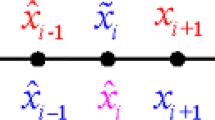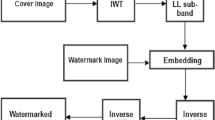Abstract
Security is unarguably the most important aspect when it comes to transmission and handling of medical data. Technological development has done wonders in the analysis of medical images as well as physiological signals. On the other hand, it posed a serious question of security threat for these signals. Schemes like cryptography, steganography, and watermarking are employed to ensure medical signal safety. All schemes have their strengths and flaws. Encryption provides a strong answer toward data security but it cannot withstand signal tampering. On the other hand, steganography is a creative method for data security but it introduces permanent changes in the signal. In proposed work, a reversible watermarking scheme has been developed for electrocardiogram (ECG) signal security. To the best knowledge of authors, proposed method is the first of its kind, i.e., capable of ownership establishment, tampering detection, and recovery of ECG signal (in case of tampering). It uses prediction error expansion (PEE) for reversible watermarking. The proposed algorithm is capable of maintaining 100% reversibility when no tampering is performed on the watermarked signal. In case of tampering, the proposed algorithm is capable of partially restoring tampered ECG signal highlighting prominent parts.















Similar content being viewed by others
Data Availability
The dataset used is publicly available on the internet.
Code Availability
The code will be made available on reasonable demand.
References
R.V. Andreão, B. Dorizzi, J. Boudy, ECG signal analysis through hidden markov models. IEEE Trans. Biomed. Eng. 53, 1541 (2006)
M.M. Bassiouni, E.S.A. El-Dahshan, W. Khalefa, A.M. Salem, Intelligent hybrid approaches for human ECG signals identification. Signal Image Video Process. 12, 941 (2018)
I. Beraza, I. Romero, Comparative study of algorithms for ECG segmentation. Biomed. Signal Process. Control 34, 166 (2017)
S. Bhalerao, I.A. Ansari, A. Kumar, D.K. Jain, A reversible and multipurpose ECG data hiding technique for telemedicine applications. Pattern Recognit. Lett. 125, 463 (2019)
S. Bhalerao, I.A. Ansari, A. Kumar, A secure image watermarking for tamper detection and localization. J. Ambient Intell. Humaniz. Comput. 1, 3 (2020)
G. Coatrieux, L. Lecornu, B. Sankur, C. Roux, A review of image watermarking applications in healthcare, in Annual International Conference of the IEEE Engineering in Medicine and Biology - Proceedings, pp. 4691–4694 (2006)
D.L. Donoho, J.M. Johnstone, Ideal spatial adaptation by wavelet shrinkage. Biometrika 81, 425 (1994)
I.C. Dragoi, D. Coltuc, Local-prediction-based difference expansion reversible watermarking. IEEE Trans. Image Process. 23, 1779 (2014)
A.L. Goldberger, L.A. Amaral, L. Glass, J.M. Hausdorff, P.C. Ivanov, R.G. Mark, J.E. Mietus, G.B. Moody, C.K. Peng, H.E. Stanley, PhysioBank, PhysioToolkit, and PhysioNet: components of a new research resource for complex physiologic signals. Circulation 101, e215–e220 (2000)
P. Gope, Y. Gheraibia, S. Kabir, B. Sikdar, A secure IoT-based modern healthcare system with fault-tolerant decision making process. IEEE J. Biomed. Heal. Inform. 1, 862 (2020)
P. Huang, B. Li, L. Guo, Z. Jin, Y. Chen, A robust and reusable ECG-based authentication and data encryption scheme for EHealth systems, in 2016 IEEE Global Communications Conference, GLOBECOM 2016 – Proceedings, vol. 1 (2016)
T. Jabeen, H. Ashraf, A. Ullah, A survey on healthcare data security in wireless body area networks. J. Ambient Intell. Humaniz. Comput. 1, 3 (2021)
S.P. Jaiswal, O.C. Au, V. Jakhetiya, Y. Guo, A.K. Tiwari, K. Yue, Efficient adaptive prediction based reversible image watermarking, in 2013 IEEE International Conference on Image Processing, ICIP 2013—Proceedings, vol. 4540 (2013)
S.E. Jero, P. Ramu, S. Ramakrishnan, ECG steganography using curvelet transform. Biomed. Signal Process. Control 22, 161 (2015)
S.E. Jero, P. Ramu, Curvelets-based ECG steganography for data security. Electron. Lett. 52, 283 (2016)
L. Johannesen, U.S.L. Grove, J.S. Sørensen, M.L. Schmidt, J.P. Couderc, C. Graff, A wavelet-based algorithm for delineation and classification of wave patterns in continuous holter ECG recordings. Comput. Cardiol. 37, 979 (2010)
Y. Kim, M. Sim, I. Moon, B. Javidi, Secure random phase key exchange schemes for image cryptography. IEEE Internet Things J. 6, 10855 (2019)
P. Laguna, R.G. Mark, A. Goldberg, G.B. Moody, Database for evaluation of algorithms for measurement of QT and other waveform intervals in the ECG. in Computers in Cardiology, vol. 673 (1997)
S. Lee, Y. Jeong, D. Park, B.J. Yun, K.H. Park, Efficient fiducial point detection of ECG QRS complex based on polygonal approximation. Sensors (Switzerland) 18, 4502 (2018)
P. Mathivanan, S. Edward Jero, P. Ramu, A. Balaji Ganesh, QR code based patient data protection in ECG steganography. Aust. Phys. Eng. Sci. Med. 41, 1057 (2018)
P. Mathivanan, ECG steganography based on tunable Q-factor wavelet transform and singular value decomposition. Int. J. Imaging Syst. Technol. 31(1), 270–287 (2020)
G.B. Moody, R.G. Mark, The impact of the MIT-BIH arrhythmia database. IEEE Eng. Med. Biol. Mag. 20, 45 (2001)
Z. Ni, Y.Q. Shi, N. Ansari, W. Su, Reversible data hiding. IEEE Trans. Circuits Syst. Video Technol. 16, 354 (2006)
Z. Pakdaman, S. Saryazdi, H. Nezamabadi-pour, A prediction based reversible image watermarking in hadamard domain. Multimed. Tools Appl. 76, 8517 (2017)
C. Priya, C. Ramya, Robust and secure video watermarking based on cellular automata and singular value decomposition for copyright protection. Circuits Syst. Signal Process. 40, 2464 (2020)
H. Qiu, M. Qiu, Z. Lu, Selective encryption on ECG data in body sensor network based on supervised machine learning. Inf. Fusion 55, 59 (2020)
N.V. Rao, V.M. Kumari, Watermarking in medical imaging for security and authentication. Inf. Secur. J. A Global Perspect. 20(3), 148–155 (2011)
A. Ricardo, P. Riera, C. Ferreira, C. Ferreira Filho, M. Ferreira, A. Meneghini, A.H. Uchida, E. Schapachnik, S. Dubner, L. Zhang, The enigmatic sixth wave of the electrocardiogram: the U wave. Cardiol. J. 15, 408 (2008)
L.D. Sharma, R.K. Sunkaria, Detection and delineation of the enigmatic U-wave in an electrocardiogram. Int. J. Inf. Technol. 136(13), 2525 (2019)
H.J. Shiu, B.S. Lin, C.H. Huang, P.Y. Chiang, C.L. Lei, Preserving privacy of online digital physiological signals using blind and reversible steganography. Comput. Methods Programs Biomed. 151, 159 (2017)
N. Tarhouni, M. Charfeddine, C. Ben Amar, Novel and robust image watermarking for copyright protection and integrity control. Circuits Syst. Signal Process. 39, 5059 (2020)
D.M. Thodi, J.J. Rodríguez, Expansion embedding techniques for reversible watermarking. IEEE Trans. Image Process. 16, 721 (2007)
J. Tian, Reversible data embedding using a difference expansion. IEEE Trans. Circuits Syst. Video Technol. 13, 890 (2003)
C. Wang, H. Zhang, X. Zhou, A self-recovery fragile image watermarking with variable watermark capacity. Appl. Sci. 8, 548 (2018)
H. Wang, W. Zhang, N. Yu, Protecting patient confidential information based on ECG reversible data hiding. Multimed. Tools Appl. 75, 13733 (2016)
Acknowledgements
The authors would like to thank Dr. G. S. Sandhu (M.D.), who is a Medical officer at PDPM IIITDM Jabalpur (India) for his valuable clinical contribution and suggestions that improved the quality of the article.
Author information
Authors and Affiliations
Corresponding author
Ethics declarations
Conflict of interest
The authors declare no conflict of interest.
Additional information
Publisher's Note
Springer Nature remains neutral with regard to jurisdictional claims in published maps and institutional affiliations.
Rights and permissions
About this article
Cite this article
Bhalerao, S., Ansari, I.A. & Kumar, A. Reversible ECG Watermarking for Ownership Detection, Tamper Localization, and Recovery. Circuits Syst Signal Process 41, 5134–5159 (2022). https://doi.org/10.1007/s00034-022-02024-4
Received:
Revised:
Accepted:
Published:
Issue Date:
DOI: https://doi.org/10.1007/s00034-022-02024-4




